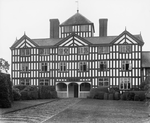Montgomery Castle
Buildings and structures completed in 1228Castle ruins in WalesCastles in PowysClan MontgomeryGrade I listed buildings in Powys ... and 3 more
Grade I listed castles in WalesMontgomery, PowysUse British English from May 2015

Montgomery Castle (Welsh: Castell Trefaldwyn) is a stone-built castle looking over the town of Montgomery in Powys, Mid Wales. It is one of many Norman castles on the border between Wales and England. Its strategic importance in the Welsh Marches meant it was destroyed and rebuilt a number of times until the early 14th century, when the area was largely pacified. During the First English Civil War, it was the site of the largest battle in Wales on 17 September 1644; the walls were slighted after the Second English Civil War in 1649 to prevent the castle being used again.
Excerpt from the Wikipedia article Montgomery Castle (License: CC BY-SA 3.0, Authors, Images).Montgomery Castle
Castle Walk,
Geographical coordinates (GPS) Address External links Nearby Places Show on map
Geographical coordinates (GPS)
| Latitude | Longitude |
|---|---|
| N 52.56253 ° | E -3.15061 ° |
Address
Castell Trefaldwyn
Castle Walk
SY15 6ES , Montgomery
Wales, United Kingdom
Open on Google Maps









